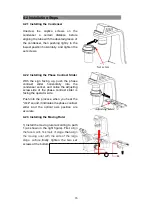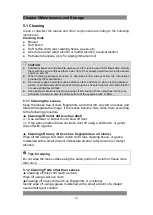
23
position, seen from the front of the
microscope: If you select the bright-field
position, the filter cube is removed from the
optical path. The three bright-field positions
have the same function.
Rotate the turret so that the fluorescence
positions indicated by the arrows on the left
and right are the same (all points to “1” in the
right figure), indicating that the filter cube has
been switched into the optical path.
★
One-to-one corresponding
relationship between filter cube sign,
fluorescent LED light signs and filter
cube should be paid attention to, when
using. (see section 4.3.2 for the
position of fluorescent LED lights)
3.11.4
Fluorescence Filter Cube
A filter cube consists of three types of optical
components: an excitation filter (BP filter), a
barrier filter (BA filter), and a dichroic mirror
(DM).
Referring to the following items as a guide,
select a desired combination of filter cubes
according to the characteristics of the
specimen and fluorophore.
• You can select a combination of an
excitation filter and a barrier filter even if you
are using the same excitation method.
• Excitation filters, barrier filters, and dichroic
mirrors can be purchased separately.
• Excitation filters are exposed to strong light
during operation and will deteriorate over
time. Replace the filter as appropriate.
3.11.5
Fluorescent LED Unit
The NIB410-FL allows you to mount up to
three different fluorescence LED units as the
light source for Episcopic fluorescence
microscopy.
When the fluorescence cube turret is rotated,
the fluorescence LED unit is switched
automatically. Therefore, mount the
fluorescence LED unit at the same address
as the filter cube to be used.
Dichroic mirror
SIGN

























